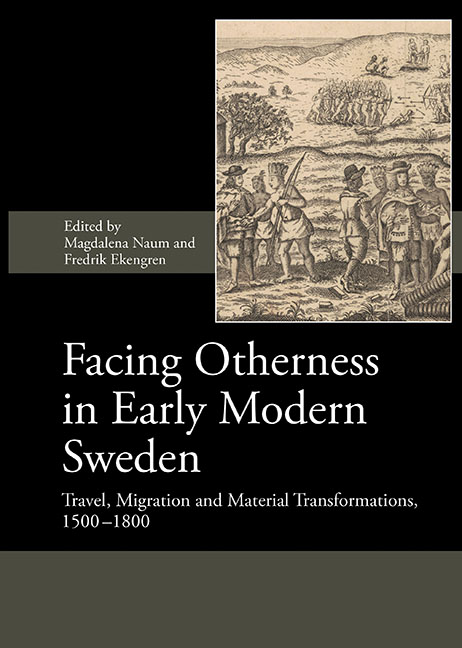Book contents
- Frontmatter
- Contents
- List of Illustrations
- List of Contributors
- Preface
- List of Abbreviations
- I Material Transformations
- II Migration and Neighbourly Interactions
- Introduction
- 6 Marrying “the Other”: Crossing Religious Boundaries in the Eastern Borderlands of the Kingdom of Sweden in the 17th Century
- 7 Ideas from Abroad: German Weavers as Agents of Large-Scale Cloth Production and a Continental Lifestyle in 17th-Century Sweden
- 8 Foreign Merchants in Early Modern Sweden: A Case of Intermarriage, Trade and Migration
- 9 Aspects of “British” Migration to Sweden in the 17th Century
- 10 Commodities, Consumption and Forest Finns in Central Sweden
- 11 Encountering “the Other” in the North – Colonial Histories in Early Modern Northern Sweden
- 12 Lapland's Taxation as a Reflection of “Otherness” in the Swedish Realm in the 17th and 18th Centuries: Colonialism, or a Priority Right of the Sami People?
- III Overseas Travel
- IV Conclusions
- Index
6 - Marrying “the Other”: Crossing Religious Boundaries in the Eastern Borderlands of the Kingdom of Sweden in the 17th Century
from II - Migration and Neighbourly Interactions
Published online by Cambridge University Press: 23 July 2019
- Frontmatter
- Contents
- List of Illustrations
- List of Contributors
- Preface
- List of Abbreviations
- I Material Transformations
- II Migration and Neighbourly Interactions
- Introduction
- 6 Marrying “the Other”: Crossing Religious Boundaries in the Eastern Borderlands of the Kingdom of Sweden in the 17th Century
- 7 Ideas from Abroad: German Weavers as Agents of Large-Scale Cloth Production and a Continental Lifestyle in 17th-Century Sweden
- 8 Foreign Merchants in Early Modern Sweden: A Case of Intermarriage, Trade and Migration
- 9 Aspects of “British” Migration to Sweden in the 17th Century
- 10 Commodities, Consumption and Forest Finns in Central Sweden
- 11 Encountering “the Other” in the North – Colonial Histories in Early Modern Northern Sweden
- 12 Lapland's Taxation as a Reflection of “Otherness” in the Swedish Realm in the 17th and 18th Centuries: Colonialism, or a Priority Right of the Sami People?
- III Overseas Travel
- IV Conclusions
- Index
Summary
Marriages between people confessing different religious faiths are not a frequently studied topic among historians. This chapter focuses on mixed marriages in the Kexholm province in the easternmost borderland of the 17th-century Swedish realm. The province was settled by Karelian people who were Orthodox and by Finns who confessed the Lutheran faith. Although relations between these groups were strained, we have proof of several mixed marriages in the protocols of the local courts. The source material is unsystematic and scant; however, it can open a small window on the daily life of these mixed couples and on the local society in which they lived.
STUDYING EARLY MODERN MARRIAGES IN THE BORDERLANDS
Marriage practices among the common people, or peasantry, are a classic topic in cultural studies but have attracted much less attention from historians, especially when it comes to the pre-modern era. Since marriage was a legal institution, the approach adopted by historians has most often been a legal one. This brief study focuses on marriages between people confessing different faiths in the eastern borderlands of 17th-century Sweden. The aim of the study is to throw light on the everyday lives of those early modern people who decided to marry a spouse of another religion. Despite laws, stipulations and common prejudices which did not favour mixed marriages, these people were ready to cross the borders between religions.
The territory concerned here is the province of Kexholm, which at that time covered an area west and north-west of Lake Ladoga that today lies on both sides of the Finnish– Russian border (Fig. 6.1). The provinces of Kexholm and Ingria were annexed to the Kingdom of Sweden under the peace treaty of 1617, but were greatly affected by the Great Northern War, which began in 1700, so that under the peace treaty of 1721 Kexholm was divided in half and its southern parts together with the whole province of Ingria were ceded to the Russian Empire while only the sparsely settled northern part of Kexholm was left in the possession of Sweden. The material available from the province of Kexholm in the Swedish period, 1617–1700, is nevertheless ideally suited to the study of the early modern borderlands.
- Type
- Chapter
- Information
- Facing Otherness in Early Modern SwedenTravel, Migration and Material Transformations 1500–1800, pp. 109 - 124Publisher: Boydell & BrewerPrint publication year: 2018



